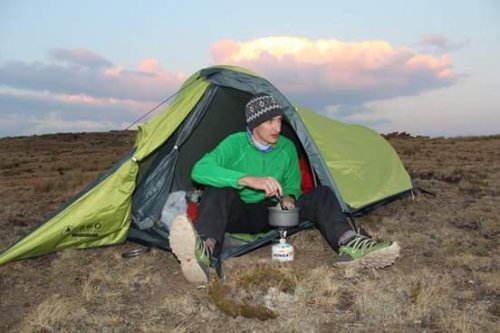Gradients of passes
07 Oct 2014 19:24 #61985
by ghaznavid
Gradients of passes was created by ghaznavid
Kind of off topic - but an observation based on my GPS track for Sani Pass vs Mashai Pass.
While slogging up Sani I have to admit that I found this pass to be much more difficult than I expected. It is most certainly harder than the likes of Langies and Saddle Nek Pass. At the time I thought I was just feeling the effects of a hot day, heavy pack and having just done 2 hard days immediately beforehand. But as I am slowly getting the hang of using Basecamp I have just found the following:
- Average gradient from 1904m to 2847m on Sani Pass is 11.8%
- Average gradient from 2867m to 1875m on Mashai Pass is 12%
As a control I took berg.co.za's Rhino Pass GPS track and did a comparison. From 2020m to 2963m comes out at 11.6%
Context: Intrepid's Manxome Pass track comes out at 38%
While walking up the pass I was actually surprised that it is possible to drive up such a steep route. While tar may make it more friendly, I would still doubt most vehicles would be able to get up it - especially in a storm.
While slogging up Sani I have to admit that I found this pass to be much more difficult than I expected. It is most certainly harder than the likes of Langies and Saddle Nek Pass. At the time I thought I was just feeling the effects of a hot day, heavy pack and having just done 2 hard days immediately beforehand. But as I am slowly getting the hang of using Basecamp I have just found the following:
- Average gradient from 1904m to 2847m on Sani Pass is 11.8%
- Average gradient from 2867m to 1875m on Mashai Pass is 12%
As a control I took berg.co.za's Rhino Pass GPS track and did a comparison. From 2020m to 2963m comes out at 11.6%
Context: Intrepid's Manxome Pass track comes out at 38%
While walking up the pass I was actually surprised that it is possible to drive up such a steep route. While tar may make it more friendly, I would still doubt most vehicles would be able to get up it - especially in a storm.
Please Log in or Create an account to join the conversation.
07 Oct 2014 20:58 #61986
by Stijn
Replied by Stijn on topic Gradients of passes
Ghaz, the problem with this comparison is that you are including long sections of gradual ascent or even flat before the passes themselves.
To get an average gradient of 12% for Mashai Pass, you're measuring it over a distance of 8.3km, which is pretty much all the way back to the office. Likewise, for an 11.6% gradient on Rhino Pass, you're averaging it over 8.1km, which includes a large chunk of the gradual approach.
Intrepid's Manxome Pass track is likely only the pass itself (1.4km if I recall correctly). Manxome is about as steep as they come for that short section, but you'll find that Mashai and Rhino (and pretty much all other Berg passes) will average well over 25% for their final 2-3km.
To get an average gradient of 12% for Mashai Pass, you're measuring it over a distance of 8.3km, which is pretty much all the way back to the office. Likewise, for an 11.6% gradient on Rhino Pass, you're averaging it over 8.1km, which includes a large chunk of the gradual approach.
Intrepid's Manxome Pass track is likely only the pass itself (1.4km if I recall correctly). Manxome is about as steep as they come for that short section, but you'll find that Mashai and Rhino (and pretty much all other Berg passes) will average well over 25% for their final 2-3km.
Please Log in or Create an account to join the conversation.
07 Oct 2014 21:11 #61987
by ghaznavid
Replied by ghaznavid on topic Gradients of passes
Fair enough.
Looking at a 3.3km distance on Mashia Pass I get 19.7%
6.4km on Sani to get a similar start and finish is 13.4%
Manxome was over 2.5km
Rhino Pass is notably a bad choice as the majority of the route is a traverse into the gully. Accounting only for the top bit, 1.7km is 30.9%
So, fair enough, Sani is not nearly as steep as the passes to which it was compared. But also consider that the top section of Sani could be done by a much more direct line if it wasn't for the walls and heavy erosion next to the road. The alternative south gully isn't even accessible due to the massive loose sand/scree field that one would have to tackle to ascend it.
That being said, I think my point may have been rendered, well, pointless
Looking at a 3.3km distance on Mashia Pass I get 19.7%
6.4km on Sani to get a similar start and finish is 13.4%
Manxome was over 2.5km
Rhino Pass is notably a bad choice as the majority of the route is a traverse into the gully. Accounting only for the top bit, 1.7km is 30.9%
So, fair enough, Sani is not nearly as steep as the passes to which it was compared. But also consider that the top section of Sani could be done by a much more direct line if it wasn't for the walls and heavy erosion next to the road. The alternative south gully isn't even accessible due to the massive loose sand/scree field that one would have to tackle to ascend it.
That being said, I think my point may have been rendered, well, pointless
Please Log in or Create an account to join the conversation.
07 Oct 2014 21:47 - 07 Oct 2014 22:02 #61988
by Smurfatefrog
Replied by Smurfatefrog on topic Gradients of passes
Here are the stats from some of my tracks, obviously a lot depends on what you consider the start of a pass. Langies the steepest, hmm something wrong here 
Please login or register to view the image attached to this post.
Last edit: 07 Oct 2014 22:02 by Smurfatefrog.
Please Log in or Create an account to join the conversation.
- Smurfatefrog
-

- Offline
- Moderator
-

Less
More
- Posts: 1101
- Thank you received: 1517
05 Nov 2014 22:23 - 05 Nov 2014 22:32 #62263
by HFc
Replied by HFc on topic Gradients of passes
(Sidenote, it is important to use the correct data for calculating gradient, it needs to be the rise divided by slope length. Slope length is the actual meters you and I had to walk/scramble/climb up a pass or peak. This way we can calculate a 1 on 1 slope such as the upper reaches of Corner pass as a gradient of 71% (it really is 63%, but bear with me). If we used the map meters we would've gotten an answer of 100% gradient, which it isn't. Devil's Tooth is what we would call 100% gradient (120 meters effort by crazyman to gain 120m altitude).
(I am sure the above examples by others were determined correctly)
Another example, and one known by most, is getting to the top of the escarpment via Sentinel Car Park.
In this instance I ascended via Beacon Buttres Gully and headed over to Mt. Amery, as reported three months ago on VE.
So, taking into account the complete ascend from Sentinel Car Park to the top of Beacon Buttres Gully one ends up with:
- Distance 3.40km (on slope, not map meters)
- Elevation gained (2560m - 3085m): 525 meters
- Gradient of route is therefore: 15.4%. Easy peasy.
Now, looking at just the pass, Beacon Buttres Gully:
- Distance on slope: 410m
- Altitude gain: 2880m to 3085m: 205m
- Gradient is therefore a neat 50%. That is steep...fortunately quite short.
PS. There are many passes with gradients above 50%, but this is made more bearable by zigzagging routes up the pass. Some of them, like Corner pass, with the last 250 odd meters at 63%, forces you to face the gradient head-on....
(I am sure the above examples by others were determined correctly)
Another example, and one known by most, is getting to the top of the escarpment via Sentinel Car Park.
In this instance I ascended via Beacon Buttres Gully and headed over to Mt. Amery, as reported three months ago on VE.
So, taking into account the complete ascend from Sentinel Car Park to the top of Beacon Buttres Gully one ends up with:
- Distance 3.40km (on slope, not map meters)
- Elevation gained (2560m - 3085m): 525 meters
- Gradient of route is therefore: 15.4%. Easy peasy.
Now, looking at just the pass, Beacon Buttres Gully:
- Distance on slope: 410m
- Altitude gain: 2880m to 3085m: 205m
- Gradient is therefore a neat 50%. That is steep...fortunately quite short.
PS. There are many passes with gradients above 50%, but this is made more bearable by zigzagging routes up the pass. Some of them, like Corner pass, with the last 250 odd meters at 63%, forces you to face the gradient head-on....
Please login or register to view the images attached to this post.
Last edit: 05 Nov 2014 22:32 by HFc.
The following user(s) said Thank You: Serious tribe
Please Log in or Create an account to join the conversation.
07 Nov 2014 09:12 #62271
by Dillon
Replied by Dillon on topic Gradients of passes
From my rough GPS track of Injisuthi Pass (my battery sadly died just before the summit), the average over the final 2.5km is around 33% with the last 600m or so being around 62%. Ouch!
Please Log in or Create an account to join the conversation.




